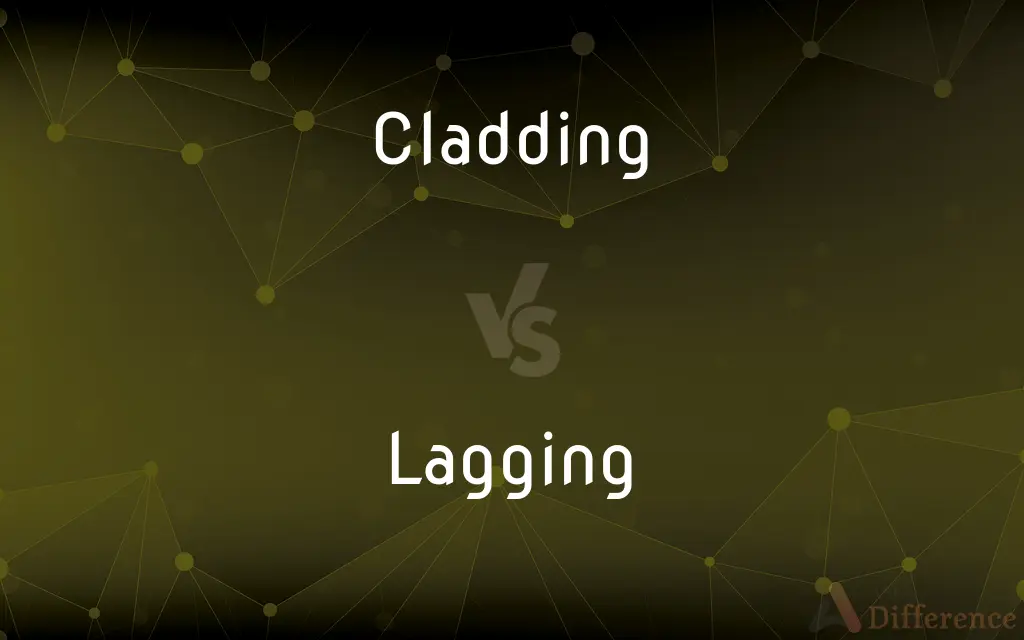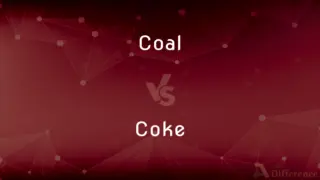Cladding vs. Lagging — What's the Difference?
By Tayyaba Rehman — Updated on October 5, 2023
Cladding refers to a material applied over another for protection or aesthetics, while Lagging is insulation, often around pipes or boilers, to conserve heat.

Difference Between Cladding and Lagging
Table of Contents
ADVERTISEMENT
Key Differences
Cladding and Lagging are both used in the context of covering or protection, but they serve different purposes. Cladding is primarily about providing a skin or layer to a structure, enhancing its appearance or protecting it from external factors. It's commonly seen in construction, where materials like wood, metal, or stone are used as Cladding for buildings, giving them a finished look or additional weather protection.
On the other hand, Lagging is about insulating, particularly to prevent heat loss. It is frequently employed in industrial settings, especially around piping systems or boilers. The purpose of Lagging is to ensure that the heat generated remains within the system, making the process more efficient and safe.
In terms of application, while Cladding is more about external visual appeal and protection, Lagging is an internal safeguard, ensuring that systems function efficiently. For example, while Cladding might be added to the exterior of a building for design purposes, Lagging would be wrapped around a pipe inside the building to keep it warm.
Thus, even though both Cladding and Lagging provide a form of cover, they differ in intent. Cladding emphasizes appearance and external protection, whereas Lagging focuses on conserving energy and maintaining internal temperatures.
Comparison Chart
Primary Purpose
Protection and aesthetics.
Insulation, especially for heat conservation.
ADVERTISEMENT
Common Contexts
Construction, buildings.
Piping systems, boilers.
Material Examples
Wood, metal, stone.
Insulative materials like foam, fiberglass.
Function
Enhance appearance or protect from elements.
Prevent heat loss, ensure efficient energy use.
External vs. Internal
Typically external.
Typically internal.
Compare with Definitions
Cladding
An external covering used to provide thermal insulation.
The Cladding on the house improved its thermal efficiency.
Lagging
Insulation around objects to prevent heat loss.
The boiler's Lagging ensures consistent heat distribution.
Cladding
Material applied over another for protection or aesthetics.
The building's stone Cladding gives it a modern look.
Lagging
Protective covering, especially for pipes or boilers.
The steam pipes had Lagging to conserve energy.
Cladding
A protective layer applied to prevent damage from elements.
The metal Cladding protects the wood underneath from rain.
Lagging
A wrap or shield to maintain temperature within a system.
Without Lagging, the hot water pipes would lose heat quickly.
Cladding
A decorative surface applied to improve appearance.
The timber Cladding added a rustic charm to the cabin.
Lagging
A covering used to provide thermal insulation, as from a steam pipe.
Cladding
A shield against external factors for durability.
The Cladding ensures the structure withstands harsh weather.
Lagging
A similar covering used to provide acoustical insulation, as on an air duct.
Cladding
A metal coating bonded onto another metal under high pressure and temperature.
Lagging
A plank or set of planks forming the outer surface of a centering for the construction of an arch.
Cladding
The process of forming such a coating.
Lagging
Any of various structural members or materials used as a protective sheathing, as on the ceiling of a mine tunnel or around a boiler.
Cladding
A protective or insulating layer fixed to the outside of a building or another structure.
Lagging
Falling behind, not keeping up the pace
Cladding
(rare) Clothing; clothes.
Lagging
Occurring after; indicating the later phase of
Cladding
Any hard coating, bonded onto the outside of something to add protection, such as the plastic sheath around an optical fibre.
Lagging
The covering of something with strips of felt, wood etc, either as insulation or for protection.
Cladding
(construction) A weatherproof, insulating or decorative covering fixed to the outside of a building.
Lagging
The material so used.
Cladding
Present participle of clad
Lagging
A prison sentence, originally one of at least three years.
Cladding
A protective covering that protects the outside of a building
Lagging
Inflection of lag
Lagging
The clothing (esp., an outer, wooden covering), as of a steam cylinder, applied to prevent the radiation of heat; a covering of lags; - called also deading and cleading.
Lagging
Lags, collectively; narrow planks extending from one rib to another in the centering of arches.
Lagging
Used to wrap around pipes or boilers or laid in attics to prevent loss of heat
Lagging
A thermal barrier to improve energy efficiency.
Adding Lagging to the attic pipes reduced the heating bill.
Lagging
A safeguard to ensure safety and effectiveness in heat systems.
Proper Lagging prevents the risk of burns from exposed hot surfaces.
Common Curiosities
Is Cladding only for buildings?
No, while commonly used for buildings, Cladding can be for any structure needing protection or an aesthetic layer.
Is Lagging visible like Cladding?
Usually, Lagging is more functional and is often hidden, unlike Cladding which can be a visible design element.
Is Lagging only about heat conservation?
Primarily, yes. Lagging is mainly used to insulate and conserve heat, especially in industrial settings.
Can Cladding provide insulation like Lagging?
Yes, some Cladding types also offer insulation, but Lagging is specifically designed for it.
Can Cladding be used inside a building?
Yes, while often external, Cladding can be used internally for aesthetic or protective purposes.
What materials are common for Lagging?
Foam, fiberglass, and mineral wool are common materials for Lagging.
How is Lagging installed?
Lagging is typically wrapped or fitted around the object and may be secured with adhesives, bands, or other methods.
Can a building have both Cladding and Lagging?
Absolutely, a building can have Cladding for aesthetics or protection and Lagging for insulation purposes.
Can Lagging be used in residential settings?
Yes, Lagging can be used in homes, especially around hot water pipes or heating systems.
Is Cladding always solid like stone or metal?
No, Cladding can be made from various materials, including composite or translucent ones.
Does Cladding require maintenance?
Depending on the material and exposure, Cladding may require periodic maintenance to retain its appearance and function.
Why is Lagging important in industrial settings?
Lagging conserves energy, improves system efficiency, and enhances safety by reducing the risk of burns or heat-related incidents.
How does Lagging contribute to energy efficiency?
By preventing heat loss, Lagging ensures systems use energy more efficiently and reduce energy waste.
Does Cladding impact building value?
Quality Cladding can enhance aesthetics and function, potentially increasing a building's value.
Can Cladding be replaced easily?
It depends on the type and installation method, but some Cladding can be relatively straightforward to replace.
Share Your Discovery

Previous Comparison
Coal vs. Coke
Next Comparison
Premium vs. PremierAuthor Spotlight
Written by
Tayyaba RehmanTayyaba Rehman is a distinguished writer, currently serving as a primary contributor to askdifference.com. As a researcher in semantics and etymology, Tayyaba's passion for the complexity of languages and their distinctions has found a perfect home on the platform. Tayyaba delves into the intricacies of language, distinguishing between commonly confused words and phrases, thereby providing clarity for readers worldwide.













































